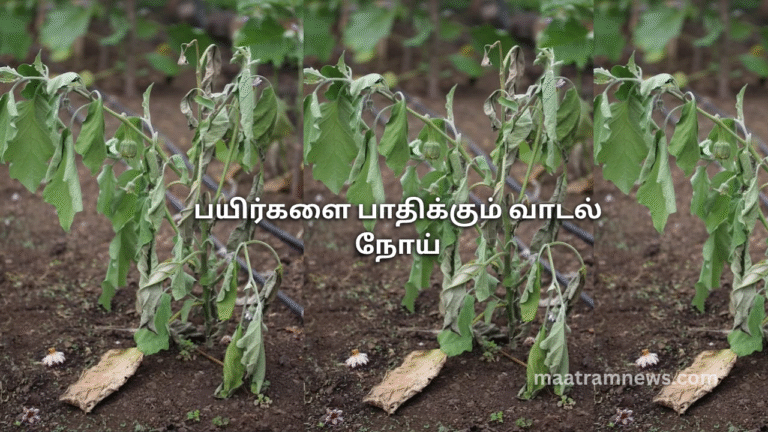பயிர்களை பாதிக்கும் வாடல் நோய்
🌱🌱🌱🌱
வாடல் நோய் என்பது பயிர்களை பாதிக்கும் பூஞ்சணம் அல்லது பக்டீறியாவால் ஏற்படும் நோயாகும். இந்த நோயானது மண், விதை அல்லது நோய் தாக்கப்பட்ட தாவர எச்சங்கள் மூலம் பரவுகிறது.
வாடல் நோய்க்குரிய நோய்க்காரணிகள், மண்ணில் நீண்ட காலம் உயிர் வாழக்கூடியவை .
சூழல் வெப்பநிலை 20–30°C க்கு இடைப்பட்ட அளவுகளில் நோயின் தீவிரம் அதிகரிக்கும் .
அதிக ஈரப்பதம் அல்லது, மழைக்காலங்களில் நோய்ப்பரவல் வேகமாக நடைபெறுகிறது .
அமிலத்தன்மை, குறைந்த பொட்டாசியம், அதிக நைதரசன் உள்ள மண்ணில் நோய் அதிகம் பரவும்.
நோயின் ஆரம்ப நிலையில் அடி இலைகள் மஞ்சளாகி வாடும்.
அடுத்த கட்டமாக இலைகள் முழுமையாக உதிர்ந்து செடிகள் காய்ந்து இறக்கும். அத்துடன் வேர்ப்பகுதி நிறம்மாறி அழுகும்.
நோய்த் தடுப்பு முறைகள்
🍃🍃🍃
உண்மையில் நோய் தாக்கிய பின் செய்யும் சிகிச்சையை விட வருமுன் காக்கும் தடுப்பு முறைகள் செலவு மிகவும் குறைந்தவை .
🌱ஒரே பயிரை தொடர்ச்சியாக பயிரிடாமல் மாற்றுப் பயிர்களை பயிரிடுதல் .
🌱நோயை எதிர்க்கும் திறன் கொண்ட இனங்களைப் பயிரிடுதல்.
🌱 சாணக் கரைசலை அல்லது ஜீவாமிர்தக் கரைசலை அடிக்கடி தெளித்தல் .
🌱கோடை காலத்தில் ஆழ உழவு செய்து மண்ணை வெயிலில் வைத்தல் (38–40°C வெப்பநிலையில் பூஞ்சணங்கள் இறக்கின்றன) .
🌱நீர்ப்பாசனம் பரிந்துரைக்கப்பட்ட அளவில் மட்டுமே செய்தல்.
🌱 நடைமுன் விதைகளை / நாற்றுகளை ட்ரைக்கடெர்மா நுண்ணுயிர் கொண்டு விதை நேர்த்தி செய்தல்.
🌱ட்ரைக்கடெர்மா, சூடோமோனஸ் மற்றும் பசிலஸ் சப்டிலீஸ் ஆகிய நுண்ணுயிர்களை ஒருசேர மண்ணில் கலந்து பயன்படுத்துதல்.
மேலதிக விபரங்கள்
CSJ Agri
076 225 0017
மேலதிக தகவல்களுக்கு மாற்றம் செய்திகள் இணையத்தளத்தினுள் பிரவேசியுங்கள்.
மேலதிக தகவல்களை உடனுக்குடன் பெற்றுக்கொள்ள மாற்றம் செய்திகள் முகநூல் பக்கத்தை பின்தொடரவும்.
Wilt Disease Affecting Crops
🌱🌱🌱🌱
Wilt disease is caused by fungi or bacteria that affect crops. This disease spreads through soil, seeds, or infected plant residues.
The pathogens responsible for wilt disease can survive in the soil for long periods.
The severity of the disease increases when the temperature ranges between 20–30°C.
High humidity or rainy seasons accelerate the spread of the infection.
Wilt disease spreads more easily in acidic soil, low in potassium, and high in nitrogen content.
In the early stage, lower leaves turn yellow and wilt.
Later, the entire plant dries up and dies, with roots showing discoloration and decay.
Preventive Measures
🍃🍃🍃
Prevention is much more cost-effective than treatment after infection.
🌱 Avoid continuous monocropping; practice crop rotation.
🌱 Use disease-resistant crop varieties.
🌱 Regularly spray organic formulations like cow dung solution or Jeevamrutha.
🌱 Conduct deep plowing during summer and expose the soil to sunlight (fungi die at 38–40°C).
🌱 Provide irrigation only at the recommended levels.
🌱 Before planting, treat seeds or seedlings with Trichoderma bio-agent.
🌱 Mix beneficial microorganisms like Trichoderma, Pseudomonas, and Bacillus subtilis into the soil for better protection.
For more details:
CSJ Agri
📞 076 225 0017



